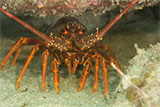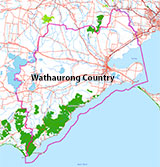Castle Rock
![]() Bommie Dive |
Bommie Dive | ![]() Boat access
Boat access
![]()
![]()
![]()
![]()
Depth: 12 m (39 ft) to 20 m (66 ft)
Level: Open Water and beyond.
Castle Rock is located outside Port Phillip Heads on the south-west, Point Lonsdale side in approximately 20 m (66 ft) of water. It rises majestically out of a limestone and sandy bottom to around 12 m (39 ft) on top.
The walls of this bommie have many undercuts, splits and ledges and with jagged rock turrets on top it's easy to see how this site got its name! The rock is around 200 m (656 ft) in circumference and can be circled once or twice in a dive. The fixed depth, lack of current and easy navigation makes this the perfect boat dive for newer Open Water divers.
But don't spend all of your dive time just exploring the base of Castle Rock. There is a lot of very interesting marine life to be found on the top.
Castle Rock is a wonderful dive with a wide variety of creatures including Nudibranchs to Seastars, typically on the top. You'll find Yellow Zoanthids plus numerous fish life including Southern Blue Devil, Old Wives, Boarfish, Dusky Morwong, Sixspine Leatherjacket, Scalyfin, Zebrafish, Bluethroat Wrasse, Senator Wrasse and Sweep hiding under the ledges. You can sometimes spot Weedy Seadragons under and around the rock. There is even a slim chance of a Southern Rock Lobster (aka Crayfish) or two under ledges at the bottom, or in the nearby reef.
Bass Strait Warning: Always keep an eye on sea conditions throughout any shore or boat dive in Bass Strait on Victoria's coastline. Please read the warnings on the web page diving-in-bass-strait before diving or snorkelling this site.
Divers have the opportunity to catch Southern Rock Lobster (aka Crayfish) at this dive site. Remember your catch bag, current Victorian Recreational Fishing Licence, rock lobster measure, and cray tags. Once you get back to the dive boat, or shore, make sure you clip the tail and tag your Crayfish as per Fisheries requirements. Please abide by all current fishing regulations if you intend to catch crays. See article-catching-crayfish for practical cray hunting advice from The Scuba Doctor, plus melbourne-cray-dives for a list of other crayfish dive sites near Melbourne. For tips on cooking your Crays, please see article-cooking-crayfish.
Finding Castle Rock
Over the years we've been provided with different GPS marks for Castle Rock. The GPS marks we know of in circulation for Castle Rock are:
- GPS (verified)
Latitude: 38° 17.887′ S (38.298117° S / 38° 17′ 53.22″ S)
Longitude: 144° 35.863′ E (144.597717° E / 144° 35′ 51.78″ E) - Geoff Rodda:
Latitude: 38° 17.888′ S (38.298133333333° S / 38° 17′ 53.28″ S)
Longitude: 144° 35.873′ E (144.59788333333° E / 144° 35′ 52.38″ E)
15 m, bearing 97°, E - Dive Victoria:
Latitude: 38° 17.882′ S (38.29803333° S / 38° 17′ 52.92″ S)
Longitude: 144° 35.868′ E (144.5978° E / 144° 35′ 52.08″ E)
12 m, bearing 37°, NE - John Lawler:
Latitude: 38° 17.893′ S (38.29821655° S / 38° 17′ 53.58″ S)
Longitude: 144° 35.858′ E (144.59763588° E / 144° 35′ 51.49″ E)
13 m, bearing 212°, SSW
Traditional Owners — This dive site is in the traditional Country of the Wathaurong (Wadda-Warrung) people of the Kulin Nation. This truly ancient Country includes the coastline of Port Phillip, from the Werribee River in the north-east, the Bellarine Peninsula, and down to Cape Otway in the south-west. We wish to acknowledge the Wathaurong as Traditional Owners. We pay respect to their Ancestors and their Elders, past, present and emerging. We acknowledge Bunjil the Creator Spirit of this beautiful land, who travels as an eagle, and Waarn, who protects the waterways and travels as a crow, and thank them for continuing to watch over this Country today and beyond.
Castle Rock Location Map
Latitude: 38° 17.887′ S (38.298117° S / 38° 17′ 53.22″ S)
Longitude: 144° 35.863′ E (144.597717° E / 144° 35′ 51.78″ E)
Datum: WGS84 |
Google Map
Added: 2012-07-22 09:00:00 GMT, Last updated: 2022-05-07 23:32:54 GMT
Source: GPS (verified)
Nearest Neighbour: Deep Pinnacles, 250 m, bearing 287°, WNW
Depth: 12 to 20 m.
Dive only on: Ebb.
[ Top ]
DISCLAIMER: No claim is made by The Scuba Doctor as to the accuracy of the dive site coordinates listed here. Should anyone decide to use these GPS marks to locate and dive on a site, they do so entirely at their own risk. Always verify against other sources.
The marks come from numerous sources including commercial operators, independent dive clubs, reference works, and active divers. Some are known to be accurate, while others may not be. Some GPS marks may even have come from maps using the AGD66 datum, and thus may need be converted to the WGS84 datum. To distinguish between the possible accuracy of the dive site marks, we've tried to give each mark a source of GPS, Google Earth, or unknown.






